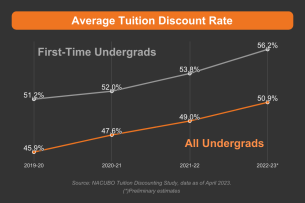Filter & Sort

Student-Facing Dashboard Provides Clarity for Advisers
A new student success database at Ithaca College focuses on individuals’ information, providing insight into academics, extracurriculars and obstacles to success.

Tuition Discount Rates Hit New High
According to a new NACUBO study, private college tuition discount rates hit a record 56.2 percent, continuing a pattern of annual increases.

On-Campus Outpatient Program Addresses Complex Student Needs
Rutgers University’s Next Step counseling services allow students to receive care and remain enrolled in the institution, eliminating barriers to higher-level counseling help.
Compilation on Transforming Colleges to Improve Student Success

Academic Success Tip: Promote LGBTQ+ Safety and Inclusion in the Field
A paper led by an Earlham College professor of biology and environmental sustainability offers best practices in LGBTQ+ inclusion in field science work.

Where STEM and the Arts Live in Harmony
The Rochester Institute of Technology offers no performance degrees, but about 10 percent of students receive an arts scholarship. The model produces well-rounded students and a sense of community.

The ‘Some College, No Credential’ Cohort Grows
National Student Clearinghouse Research Center report documents an increase in learners with college credits but no credential and finds they are returning to college at lower rates than in the past.
Opening Up College-Prep Programs
The decades-old rules don’t make sense, advocates say, and hinder efforts to better serve low-income and first-generation students.
Pagination
Pagination
- 140
- /
- 608